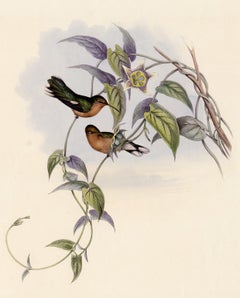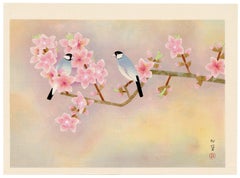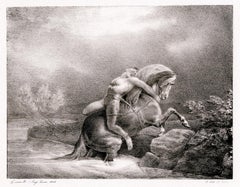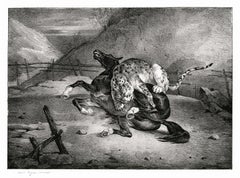Want more images or videos?
Request additional images or videos from the seller
1 of 3
Simon BussyThe Black Cat1927
1927
$350List Price
About the Item
About the Seller
5.0
Recognized Seller
These prestigious sellers are industry leaders and represent the highest echelon for item quality and design.
Platinum Seller
Premium sellers with a 4.7+ rating and 24-hour response times
Established in 1995
1stDibs seller since 2016
324 sales on 1stDibs
Typical response time: 1 hour
Associations
International Fine Print Dealers Association
Authenticity Guarantee
In the unlikely event there’s an issue with an item’s authenticity, contact us within 1 year for a full refund. DetailsMoney-Back Guarantee
If your item is not as described, is damaged in transit, or does not arrive, contact us within 7 days for a full refund. Details24-Hour Cancellation
You have a 24-hour grace period in which to reconsider your purchase, with no questions asked.Vetted Professional Sellers
Our world-class sellers must adhere to strict standards for service and quality, maintaining the integrity of our listings.Price-Match Guarantee
If you find that a seller listed the same item for a lower price elsewhere, we’ll match it.Trusted Global Delivery
Our best-in-class carrier network provides specialized shipping options worldwide, including custom delivery.You May Also Like
(after) Max Ernst - Blue Bird - Stencil
By (after) Max Ernst
Located in Collonge Bellerive, Geneve, CH
Max Ernst (after) - Blue Bird - Stencil
Published in the deluxe art review, XXe Siecle, 1958
Dimensions: 32 x 25 cm
Publisher: G. di San Lazzaro.
Max Ernst was born in Bruhl, a place near Cologne, in Germany. He was raised in a strict Catholic family, and both of his parents were disciplinarians who were dedicated to training their children into God-fearing and talented individuals. Although his father was deaf, Ernst learned so much from him, particularly when it comes to painting. In fact, much of his early years were lived under the inspiration of his father who was also a teacher. He was the one who introduced painting to Ernst at an early age.
In 1914, Ernst attended the University of Bonn where he studied philosophy. However, he eventually dropped out of school because he was more interested in the arts. He claimed that his primary sources of interest included anything that had something to do with painting. Moreover, he became fascinated with psychology, among other subjects in school.
Primarily, Ernst's love for painting was the main reason why he became deeply interested with this craft and decided to pursue it later on in his life. During his early years, he became familiar with the works of some of the greatest artists of all time including Claude Monet, Paul Cezanne and Vincent van Gogh. He was also drawn to themes such as fantasy and dream imagery, which were among the common subjects of the works of Giorgio de Chirico.
During World War I, Ernst was forced to join the German Army, and he became a part of the artillery division that exposed him greatly to the drama of warfare. A soldier in the War, Ernst emerged deeply traumatized and highly critical of western culture. These charged sentiments directly fed into his vision of the modern world as irrational, an idea that became the basis of his artwork. Ernst's artistic vision, along with his humor and verve come through strongly in his Dada and Surrealists works; Ernst was a pioneer of both movements.
It was Ernst's memories of the war and his childhood that helps him create absurd, yet interesting scenes in his artworks. Soon, he took his passion for the arts seriously when he returned to Germany after the war. With Jean Arp, a poet and artist, Ernst formed a group for artists in Cologne. He also developed a close relationship with fellow artists in Paris who propagated Avant-Garde artworks.
In 1919, Ernst started creating some of his first collages, where he made use of various materials including illustrated catalogs and some manuals that produced a somewhat futuristic image. His unique masterpieces allowed Ernst to create his very own world of dreams and fantasy, which eventually helped heal his personal issues and trauma. In addition to painting and creating collages, Ernst also edited some journals. He also made a few sculptures that were rather queer in appearance.
In 1920s, influenced by the writings of psychologist Sigmund Freud, the literary, intellectual, and artistic movement called Surrealism sought a revolution against the constraints of the rational mind; and by extension, they saw the rules of a society as oppressive. Surrealism also embraces a Marxist ideology that demands an orthodox approach to history as a product of the material interaction of collective interests, and many renown Surrealism artists later on became 20th century Counterculture symbols such as Marxist Che Guevara. In 1922 Ernst moved to Paris, where the surrealists were gathering around Andre Breton. In 1923 Ernst finished Men Shall Know Nothing of This, known as the first Surrealist painting. Ernst was one of the first artists who apply The Interpretation of Dreams by Freud to investigate his deep psyche in order to explore the source of his own creativity. While turning inwards unto himself, Ernst was also tapping into the universal unconscious with its common dream imagery.
Despite his strange styles, Ernst gained quite a reputation that earned him some followers throughout his life. He even helped shape the trend of American art during the mid-century, thanks to his brilliant and extraordinary ideas that were unlike those of other artists during his time. Ernst also became friends with Peggy Guggenheim, which inspired him to develop close ties with the abstract expressionists.
When Ernst lived in Sedona, he became deeply fascinated with the Southwest Native American navajo art. In fact, the technique used in this artwork inspired him and paved the way for him to create paintings that depicted this style. Thus, Ernst became a main figure of this art technique, including the rituals and spiritual traditions included in this form of art. Pollock, aside from the other younger generations of abstract expressionists, was also inspired by sand painting of the Southwest...
Category
1950s Surrealist Animal Prints
Materials
Stencil
After Georges Braque - Oiseaux - Pochoir
By Georges Braque
Located in Collonge Bellerive, Geneve, CH
after Georges Braque
Oiseaux
Color Pochoir on Paper
Published in the deluxe art review, XXe Siecle (issue number 11 "Les nouveaux rapports de l'art et de la nature")
1958
Dimensions:...
Category
1950s Modern Figurative Prints
Materials
Stencil
Three Hens by Georges Manzana Pissarro - Animal stencil
By Georges Henri Manzana Pissarro
Located in London, GB
Three Hens by Georges Manzana Pissarro (1871-1961)
Pochoir
31.8 x 48.3 cm (12 ½ x 19 inches)
Signed with Estate stamp and épreuve d'état
Provenance
Private Collection, London
Artis...
Category
19th Century Post-Impressionist Animal Prints
Materials
Stencil
$1,750
H 12.52 in W 19.02 in
Magpie by Georges Manzana Pissarro - Stencil art, Animal
By Georges Henri Manzana Pissarro
Located in London, GB
Magpie by Georges Manzana Pissarro (1871-1961)
Pochoir
26.5 x 45 cm (10 ³/₈ x 17 ³/₄ inches)
Signed lower right manzana - Pissarro and numbered 2/100
Artist biograpraphy:
Like all s...
Category
1920s Animal Prints
Materials
Stencil
$1,906
H 10.44 in W 17.72 in
Les poules by Georges Manzana Pissarro - Stencil
By Georges Henri Manzana Pissarro
Located in London, GB
Les poules by Georges Manzana Pissarro (1871-19610
Pochoir
30 x 46 cm (11 ³/₄ x 18 ¹/₈ inches)
Signed with Estate stamp Manzana Pissarro and numbered 7/100 lower left
Artist biograp...
Category
20th Century Animal Prints
Materials
Stencil
$1,838
H 11.82 in W 18.12 in
The Protectress
Located in San Francisco, CA
This artwork titled "The protectress" 1997 is a original stone cut with stencil on thin paper by noted Canadian Inuit artist Kakulu Saggiaktok, 1940-...
Category
Late 20th Century Other Art Style Animal Prints
Materials
Stencil
Horses in a Mythological Landscape - Lithograph
By Giorgio De Chirico
Located in Paris, IDF
Giorgio de CHIRICO
Horses in a Mythological Landscape, c. 1955
Lithograph and stencil (Jacomet workshop)
Printed signature in the plate
On light vellum 48 x 38 cm (c. 19 x 15 in)
V...
Category
1950s Surrealist Animal Prints
Materials
Lithograph, Stencil
$1,138 Sale Price
20% Off
H 18.9 in W 14.97 in
Salvador Dali "The Raven and the Fox"
By Salvador Dalí
Located in Boston, MA
Artist: Dali, Salvador
Title: The Raven and the Fox
Series: Le Bestiaire de la Fontaine
Date: 1974
Medium: drypoint with color added by stencil
Framed Dimensions: 35.75" x 28"
S...
Category
1970s Surrealist Prints and Multiples
Materials
Stencil, Drypoint
$4,000 Sale Price
20% Off
H 35.75 in W 28 in D 1 in
Brunelleschi, Composition, La Leçon d'amour dans un parc (after)
By Umberto Brunelleschi
Located in Southampton, NY
Lithograph and stencil on vélin d’Arches paper. Unsigned and unnumbered, as issued. Good condition. Notes: From the volume, La Leçon d'amour dans un parc, 1933. Published by Éditions...
Category
1930s Modern Landscape Prints
Materials
Lithograph, Stencil
$1,436 Sale Price
20% Off
Free Shipping
H 13.11 in W 10.039 in
SLAVE TO FASHION, Signed Lithograph, City Woman Walking Dog, Animal Print Coat
By Robin Morris
Located in Union City, NJ
SLAVE TO FASHION by the woman artist Robin Morris, is an original limited edition lithograph printed using hand lithography techniques(not a photo reproduction or digital print) on a...
Category
1980s Art Deco Portrait Prints
Materials
Lithograph
$448 Sale Price
42% Off
H 39 in W 26 in
More From This Seller
View AllLeucippus Fallax (Buffy Hummingbird) — Original Hand-colored Lithograph
By John Gould and Henry Constantine Richter
Located in Myrtle Beach, SC
John Gould, 'Leucippus Fallax' (Buffy Hummingbird), original lithograph with hand-coloring (not a reproduction), c. 1850. Signed in typeset 'J. Gould and H. C. Richter, del et lith.'...
Category
1850s Realist Animal Prints
Materials
Lithograph
'Inside the Flowers' (Java Sparrow and Peach Blossoms) — Mid-Century Japanese
Located in Myrtle Beach, SC
Shoko Uemura, 'Inside the Flowers (Java Sparrow and Peach Blossoms)', color woodcut, c. 1950s, edition 300. Signed in ink with the artist’s red seal beneath. A superb impression, with fresh, delicate colors, on cream wove Japan paper; the full sheet with margins (9/16 to 1 3/8 inches), in excellent condition. Archivally sleeved, unmatted.
Image size 12 3/4 x 18 1/2 inches (324 x 470 mm); sheet size 14 3/4 x 20 3/16 inches (375 x 513 mm).
Published by The Momose Print Company of Tokyo.
ABOUT THE ARTIST
Uemura Shoko (1902-2001) was the son of the famous shin-hanga artist Uemura Shoen...
Category
1950s Showa Animal Prints
Materials
Woodcut
'Mazeppa' — 19th-Century French Romanticism
By Jean Louis Andre Theodore Gericault
Located in Myrtle Beach, SC
Théodore Géricault and Eugène Lami, 'Mazeppa' from the series 'Oeuvres de Lord Byron', lithograph, 1823, 2nd state of 3, Delteil 94. Rendered by Thé...
Category
1820s Romantic Animal Prints
Materials
Lithograph
'Horse Attacked by Tiger' — 19th-Century French Romanticism
By Jean Louis Andre Theodore Gericault
Located in Myrtle Beach, SC
Théodore Géricault (after), 'Tigre dévorant un cheval' (Tiger Devouring a Horse), lithograph, 3rd state of 3, Clement 97, c. 1820. Lettered 'Volmar ...
Category
1820s Romantic Animal Prints
Materials
Lithograph
'Pups in the Pit' — American Realism
Located in Myrtle Beach, SC
William Wind McKim, 'Pups in the Pit', lithograph, 1967, edition c. 50. Signed and titled in pencil. A fine, richly-inked impression, on cream wove paper, with full margins (1 1/8 to...
Category
1940s American Realist Animal Prints
Materials
Lithograph
'Le maréchal flamand' (The Flemish Blacksmith) — 19th-Century French Romanticism
By Jean Louis Andre Theodore Gericault
Located in Myrtle Beach, SC
Théodore Géricault 'Le maréchal flamand' (The Flemish Blacksmith) from the series ‘Etudes, de chevaux lithographiés,’ lithograph, 1822, 2nd state ...
Category
1820s Romantic Animal Prints
Materials
Lithograph



